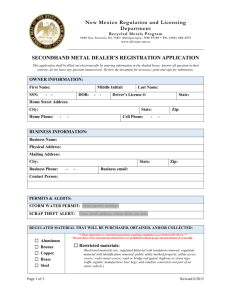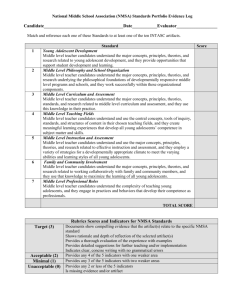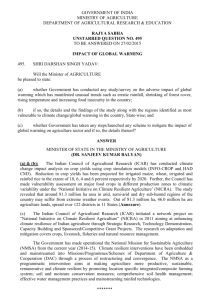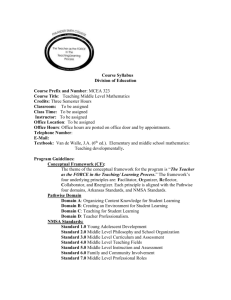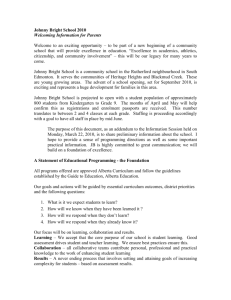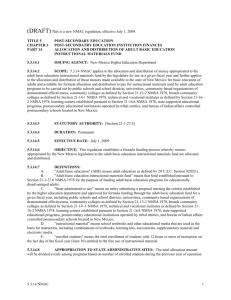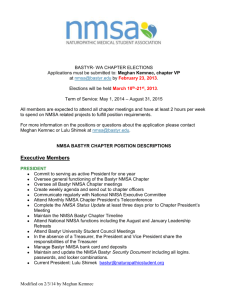course syllabus - Philander Smith College
advertisement
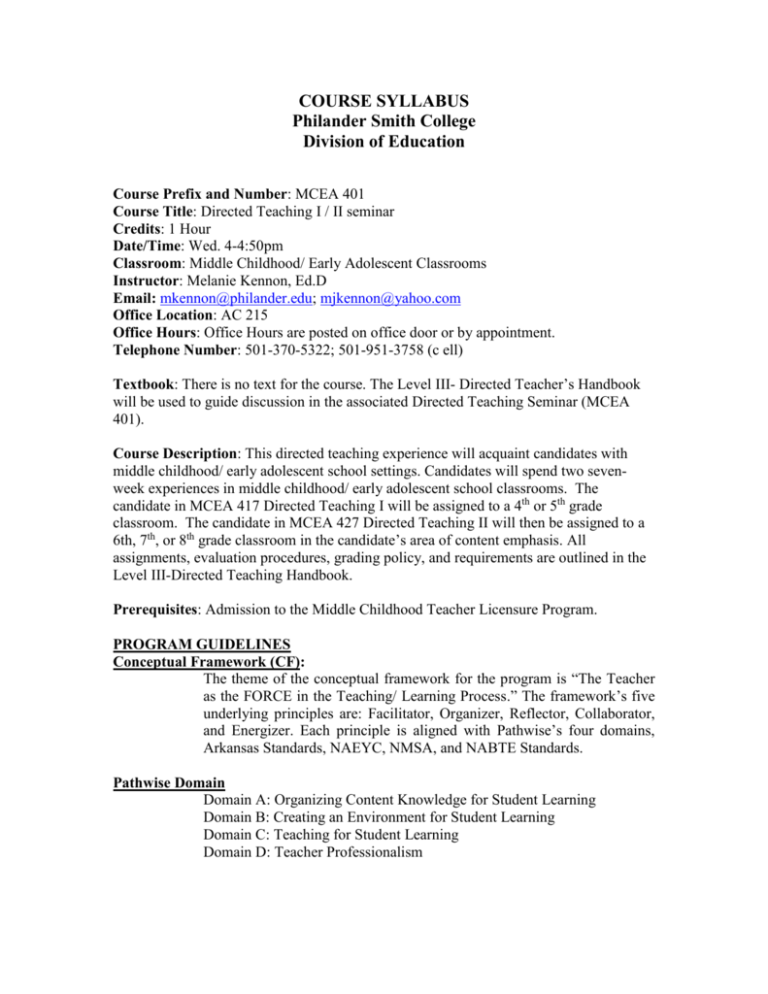
COURSE SYLLABUS Philander Smith College Division of Education Course Prefix and Number: MCEA 401 Course Title: Directed Teaching I / II seminar Credits: 1 Hour Date/Time: Wed. 4-4:50pm Classroom: Middle Childhood/ Early Adolescent Classrooms Instructor: Melanie Kennon, Ed.D Email: mkennon@philander.edu; mjkennon@yahoo.com Office Location: AC 215 Office Hours: Office Hours are posted on office door or by appointment. Telephone Number: 501-370-5322; 501-951-3758 (c ell) Textbook: There is no text for the course. The Level III- Directed Teacher’s Handbook will be used to guide discussion in the associated Directed Teaching Seminar (MCEA 401). Course Description: This directed teaching experience will acquaint candidates with middle childhood/ early adolescent school settings. Candidates will spend two sevenweek experiences in middle childhood/ early adolescent school classrooms. The candidate in MCEA 417 Directed Teaching I will be assigned to a 4th or 5th grade classroom. The candidate in MCEA 427 Directed Teaching II will then be assigned to a 6th, 7th, or 8th grade classroom in the candidate’s area of content emphasis. All assignments, evaluation procedures, grading policy, and requirements are outlined in the Level III-Directed Teaching Handbook. Prerequisites: Admission to the Middle Childhood Teacher Licensure Program. PROGRAM GUIDELINES Conceptual Framework (CF): The theme of the conceptual framework for the program is “The Teacher as the FORCE in the Teaching/ Learning Process.” The framework’s five underlying principles are: Facilitator, Organizer, Reflector, Collaborator, and Energizer. Each principle is aligned with Pathwise’s four domains, Arkansas Standards, NAEYC, NMSA, and NABTE Standards. Pathwise Domain Domain A: Organizing Content Knowledge for Student Learning Domain B: Creating an Environment for Student Learning Domain C: Teaching for Student Learning Domain D: Teacher Professionalism Arkansas Licensure Standards 1. The teacher understands the central concepts, tools of inquiry, and structures of the discipline(s) he or she teaches. 2. The teacher plans curriculum appropriate to the students, to the content, and to course objectives. 3. The teacher plans instruction based on human growth and development, learning theory, and the needs of students. 4. The teacher exhibits human relations skills, which support the development of human potential. 5. The teacher works collaboratively with school colleagues, parents/guardians, and the community to support students’ learning. NMSA Standards: Standard 1. Young Adolescent Development. Standard 2. Middle Level Philosophy. Standard 3. Middle Level Curriculum and Assessment. Standard 4. Middle Level Teaching Fields. Standard 5. Middle Level Instruction and Assessment. Standard 6. Family and Community Involvement. Standard 7. Middle Level Professional Roles Course Objectives: 1. Become more knowledgeable about the scientific and artistic dimensions of teaching in a real classroom setting. (CF: 2.2.2, 5.5.5; NMSA: 3, 4, 7; Domains A1, C2) Assessment: Assignments 1, 2, 6, 13 2. Conceptualize the interactions of social, cultural, philosophical, and professional variables influencing the teaching process. (CF: 2.2.1, 2.2.3, 3.3.6, 5.5.2; NMSA: 2, 6, 7; Domain A1, A2, D3) Assessment: Assignment 8, 13, 14 3. Strengthen their knowledge of and develop skills in the areas of classroom management. (CF: 1.1.4, 1.1.5, 1.1.6; NMSA: 1, 5; Domain B4, B5) Assessment: Assignment 1, 13, 14 4. Manage the learning environment through planning, presenting, and evaluating instruction. (CF: 1.1.6, 2.2.2, 2.2.8, 2.2.9, 3.3.1, 4.4.4, 4.4.5, 4.4.6; NMSA: 5; Domain: A1, A4, A5, B5, C2, C3, C4, D1) Assessment: Assignment 2, 4, 6 5. Improve their level of competence and confidence in using the professional and technological skills they are developing. (CF: 3.3.2, 3.3.3, NMSA: 7; Domain: D1, D2) Assessment: Assignment 2, 10, 12 6. Develop an appreciation for cultural differences and values. (CF: 2.2.1, 2.2.3, 2.2.8, 5.5.2; NMSA: 1, 6 ; Domain: A1,A2, A4 )Assessment Assignments 1, 13, 14, 15 7. Participate more fully in the real world of students and the school community in the teaching/learning process. (CF: 3.3.6, 3.3.8; NMSA: 6, 7; Domain: D3, D4) Assessment: Assignment 2, 6, 9, 13, 14 8. Apply theories and concepts specifically in college courses to the school classroom setting while the candidates are working with individual or small groups of students.(CF: 1.1.4, 1.1.5, 2.2.2, 2.2.3, 2.2.9, 3.3.7, 4.4.4, 4.4.5, 4.4.6; NMSA: 3, 5; Domain: A1, B4, C2, C3, C4, D3) Assessment: Assignment 1, 2, 3, 4, 5, 6, 7, 8, 9,10 . Dispositions: Upon completion of this course, candidates will be able to: 1. demonstrate a sense of caring (CF:1.1.1, 1.1.2, 3.3.3, 5.5.3; NMSA: 2; Domain D2). Assessment: Assignment 2, 11, 12, 14. 2. demonstrate how to establish rapport with children (CF: 1.1.1, 1.1.2, 3.3.3, 5.5.3; NMSA: 1, 2; Domain D2). Assessment: Assignment 2, 12, 14 3. demonstrate a sense of efficacy (CF: 1.1.1,1.1.2, 3.3.3, 5.5.3; NMSA: 5; Domain D2). Assessment: Assignment 2, 12, 13, 14, 15. 4. demonstrate how to model a positive attitude towards children (CF: 1.1.1; 1.1.2, 3.3.3; 5.5.3; NMSA: 5; Domain D2). Assessment: Assignment 2, 12, 13, 14, 15 5. demonstrate how to model respect for children (CF: 1.1.1, 1.1.2, 3.3.3, 5.5.3; NMSA: 5; Domain D2). Assessment: Assignment 2, 12 Assignments: 1. Demonstrate knowledge of various strategies for working with students individually and in small groups; 2. Plan and direct learning experiences for the entire class for a minimum of ten days for each seven week placement; 3. Select, construct, and arrange exhibit materials for bulletin boards which support, extend or teach concepts; 4. Develop five activities for teaching across the curriculum; 5. Demonstrate knowledge of various strategies and management styles for guiding and directing students through the entire teaching/learning process; 6. Demonstrate proficiency in planning, teaching, and directing classroom experiences; 7. Correlate and compare sound research-based pedagogy with classroom experiences; 8. Use school and community resources to complement the instructional process; 9. Demonstrate an understanding of the mental, emotional, social, and physical development of students and how each impacts the teaching/learning process; 10. Demonstrate an understanding of how to use technology effectively in the teaching/learning process; 11. Attend parent/teacher conferences with the cooperating teacher and be prepared to participate, if permitted; 12. Make a video of one lesson, if permitted by the cooperating teacher and or principal; 13. Attend directed teaching seminars; 14. Complete daily journal entries; and, 15. Complete the exit portfolio. Students with Disabilities Policy: The policy of Philander Smith College is to accommodate students with disabilities pursuant to federal and state laws, as well as, the College’s commitment to equal opportunity for all students. Any student with a disability who needs accommodations, for example, in setting placement, arrangements for examinations, or class location, etc. should, contact the Integrated Campus Center to complete a registration form. Attendance Policy: This course adheres to the attendance policy outlined in the Level III Directed Teachers Handbook.

